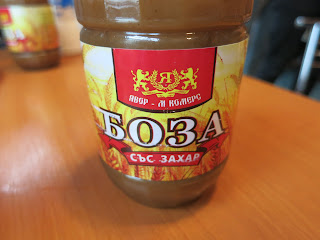The house had a nice size garden and her family grows a variety of herbs.
Welcome amuse bouche. Nicely acidic with rice vinegar.
Also, she served a tea made with the flower (shown behind the tea) from the garden. The photo doesn't show it unfortunately, but it's a nice blue drink. I've seen purplish drinks but this was really blue and no artificial color added.
Now the cooking class began. The class was very informative. She started to explain Belacan, which is a key ingredient to many of Malaysian foods. Belacan is fermented shrimp. Shrimp paste is used in most southeast Asian countries with different names. But it seems shrimp paste is more popular in Malaysia. Original shrimp paste is quite stinky, so it's fried to reduce the stickiness and increase umami. In addition, the product below is dried - the chef recommended this type because it's easy to use and also keeps for long time. I was planning to buy a few to bring back home but I forgot.... I hope I can find it at the local Asian Market.
The chef gave me options to grind ingredients, either by food processor or mortar & pestle. Of course I asked more more traditional method, which is mortar & pestle although it takes longer. She told me this particular mortar & pestle is made from stone and it's not made anymore.
This is my most favorite dish of the 4, Kerabu Okra. The topping is the ground belacan, chili and other seasonings along with shallot. We made two versions, cooked and uncooked. I thought I would like the cooked version because of the cooked shallots and more cohesive flavors. But surprisingly, I much prefer the uncooked toppings because of the freshness.
Another interesting dish is the dessert, sweet potato and coconut balls. The ball is made with rice flour so that this is gluten free. I don't care if my foods are gluten free or not. But many Asian dishes are naturally gluten free.
Here are the 4 dishes and a drink (Teh Tarik) I made. The other 2 dishes included Chicken Rendang (stewed chicken) and Char Koay Teow (Stir fried noodle). They are both very popular dishes in Malaysia. Beef Rendang is better known but it wasn't on the list, unfortunately. Teh Tarik is a black tea mixed with condensed milk.
The seasoning and flavors are more modest compared to the neighboring countries, such as Thailand, India and Indonesia. Normally the seasoning tend to be heavy in the tropical to sub tropical area because of the heat. I would have liked a bit more kick while I'm in such hot and humid place, though.
I'm flying to Singapore tomorrow. Using the 10 hours of layover, I'm going to join another food tasting tour.























































